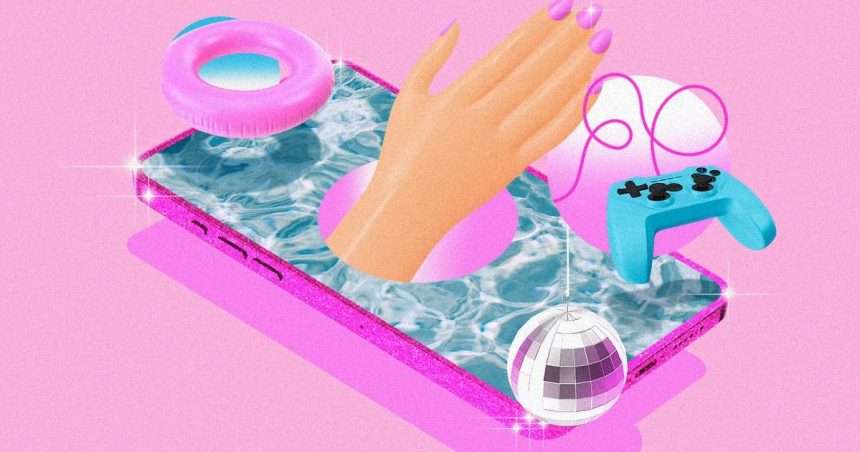This summer, we’re all Barbie girls living in a Barbie world.
Ahead of this Friday’s release of the Greta Gerwig-directed film Barbie, a marketing campaign about as large as the iconic doll’s ever-expanding wardrobe has painted the whole world hot pink. Barbie and her cohorts have been nearly inescapable: There have been billboards and branded beauty products, fashion collabs and frozen yogurt, trailers and TikTok trends.
Barbie’s Dreamhouse—which, apparently, is insured by Progressive—was brought to life on an HGTV home makeover show, while Airbnb rented out a separate magenta mansion. A Barbie boat docked in Boston Harbor for an evening of neon revelry. Contestants on ABC’s The Bachelorette donned Ken-inspired outfits in a special segment.
“They’ve stretched the IP to its limit,” Moche Isaacian, a brand strategist who cataloged Barbie’s marketing efforts in a Twitter thread that has since gone viral, said. “It feels like almost every single piece of Barbie and its universe has been brought to life.”
The complete and total Barbiefication of 2023 comes at a key moment for the world’s leading doll brand, which underwent a successful brand turnaround in the late 2010s but has in recent quarters reported slumping sales. And it arrives at perhaps an even more critical moment for Warner Bros., which has slashed jobs and removed some programming from its streaming library as it scrambles to cut costs and chart a course toward profitability.
With a full-glam marketing effort and various viral trends to bolster Barbie’s chances of success, all signs point to the film being, somewhat inexplicably, a runaway hit. The Barbie brand’s unique malleability, shoppability, and Instagrammability have given the iconic doll the power to make potential theatergoers see pink. “This is a marketing campaign that’s become bigger than the movie itself,” Paul Dergarabedian, a senior media analyst with the measurement firm Comscore, told Marketing Brew.
Toy story
In theory, there’s nothing particularly special about bringing Barbie to the silver screen.
Mattel, which was co-founded by Barbie inventor Ruth Handler and her husband Elliot a half-century ago, has done it before, releasing dozens of Barbie-branded direct-to-video and made-for-television animated movies. More broadly, toy brands turned movies themselves are already plentiful, including franchises like Transformers, G.I. Joe, and the Lego movies; Mattel alone has 13 more toy-based films in the works and several dozen in development.
Brand movies are also on the upswing, like Air (based on Nike’s Air Jordan sneakers), Flamin’ Hot (based on the Cheetos snack), and Unfrosted: The Pop-Tart Story.
Why, then, has Barbie found such sticking power ahead of the movie’s release? There are a few reasons, including the character’s cross-generational charm, Geetha Ranganathan, a senior media analyst at Bloomberg Intelligence, said. First introduced to the world in 1959, Barbie lends the new film an “evergreen” quality, she told Marketing Brew, and the PG-13-rated Barbie has the potential for four-quadrant appeal, meaning that it is likely to attract men and women over and under the age of 25.
“It really is a crowd-pleaser all around, from both a consumer perspective and a brand perspective,” Ellyn Briggs, brands analyst at Morning Consult, told Marketing Brew.
Another potential point of attraction for theatergoers? The sense of mystery about the film’s plot and tone, which has been somewhat hard to discern from promotional materials.
“There’s a curiosity factor,” Dergarabedian said. “People have been trying to get a handle on what Greta Gerwig and this creative team are gonna do with this. Is it a social commentary? Is it a parody? Is it a straight-up comedy? Is it a hybrid of all those things?” One way to find out, of course, is to buy a movie ticket.
Life in plastic
There’s another element to the Barbie brand that gives its marketing plenty of room to play: Its ability to be, well, fun. Unlike more serious films, marketing for Barbie can be and has been endlessly playful, Isaacian said.
Get marketing news you’ll actually want to read
The email newsletter guaranteed to bring you the latest stories shaping the marketing and advertising world, like only the Brew can.
“Basically, it’s Barbie’s world and we’re living in it, and that can apply to anything,” he said.
That playfulness has translated to the many dozens of brand partnerships that have rolled out, from Xbox’s Dreamhouse-themed console to Barbie Dreamhouse-like furnishings from Joybird and Ruggable. The movie and the brand “lends itself to a very retail-based marketing, which is unusual,” Dergarabedian said, and those kinds of consumer product partnerships often mean the added benefit of sharing marketing costs while boosting scale.
Add all that to a surging interest from audiences in nostalgic content and a brand code that translates to visual-heavy social platforms like TikTok and Instagram, where user-generated content promoting Barbie has shined. The #barbiecore hashtag on TikTok alone has received a collective 581 million views and counting, and a Barbie selfie generator has encouraged social media users to create and share their own bespoke images.
“Something that stands out to me about the Barbie brand that lets it translate so well to viral social moments is the aesthetic of the brand—the hot pink, the glitz, the glam,” Briggs told Marketing Brew. “What the Barbie brand stands for—girlhood, fashion, and beauty—all point to things that are exactly what we know are historically very popular on the internet.”
That will likely extend into opening weekend itself, when social media users will chronicle their own trips to the movie theater, Dergarabedian said.
“I bet there will be people taking pictures of themselves wearing pink clothes in movie-theater lobbies,” he said. “That’s money in the bank. That’s a marketer’s dream.”
Let’s go party
As Barbie excitement has surged, so has online chatter,which has only boosted Barbiemania further. More than a year ago, a first-look image of star Margot Robbie and photos of Robbie and costar Ryan Gosling stirred online conversation and curiosity, while a more recent article about a pink paint shortage supposedly due in part to the amount of fuchsia lacquer needed for Barbie’s set went viral.
Barbie has also been part of a phenomenon concurrently dubbed “Barbenheimer,” “Barbieheimer,” and “Oppenbarbie,” which encourages back-to-back screenings of Barbie and the Christopher Nolan-directed nuclear-weapons drama Oppenheimer, invoking some sort of moviegoing whiplash. Even Tom Cruise, the star of this summer’s action blockbuster Mission: Impossible – Dead Reckoning Part One, jumped in. “I love a double feature,” he wrote on Twitter, “and it doesn’t get more explosive (or more pink) than one with Oppenheimer and Barbie.”
On top of that, both films are arriving in the first year that media analysts anticipate that the summer box office will finally roar back to life, and there is a Barbie-like optimism to prove the viability of the box office once again. So far, AMC has reported that more than 20,000 people have purchased same-day tickets for both films, and some analysts are anticipating that Barbie just might lend a boost to other titles, too.
“I think the halo effect could extend beyond these movies to the rest of the summer blockbuster season, and then into the fall,” Briggs said. “It could really be a watershed type of moment for the movie industry, getting people back into theaters and getting them excited about going to the movies.”
Read the full article here










